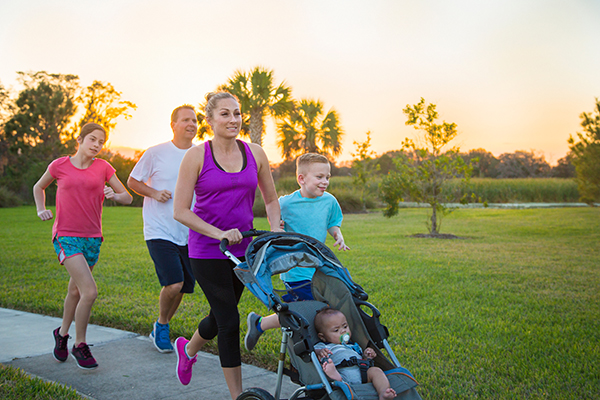
Walking is said to be one of the simplest and easiest ways to sneak in physical activity into your daily routine. It is a perfectly viable form of exercise that is both low-risk and accessible to most people, especially older adults.
A study published in JAMA Cardiology expounded on this finding. The researchers looked at almost 6,000 women in the U.S. aged between 63 and 99 years old. They were observed roughly 7.5 years to find the possible correlation between daily step count and the likelihood of heart failure.
The study authors discovered that women who walked less than 2,000 steps daily face a higher risk of heart failure. In contrast, those who walked more than 2,500 steps daily had a lower risk of heart failure. According to the researchers, walking 3,600 steps marked a 26 percent lower risk of heart failure in the study participants.
The revelation that merely taking at least 2,000 steps daily can foster a healthier heart signifies progress in physical well-being and a shift in how we perceive exercise.
What has set these findings apart is their challenge to prevailing exercise guidelines – often centered on moderate to vigorous exercise or physical activity. The study suggested that light physical activity – simply denoted by increased movement throughout the day – was equally advantageous for heart health. This notion marked a shift in understanding exercise's role in preserving cardiovascular health, particularly among older demographics.
Moreover, the research underscored the significance of reducing sedentary periods. Each additional hour and a half of inactivity heightened heart failure risk by 17 percent, emphasizing the importance of and the need for regular movement throughout the day. This highlighted the message that every step matters and that increased mobility is pivotal for heart health.
Counting every step you take
According to Harvard Medical School, walking 2,000 steps with an average stride equates to covering a mile (5,000 feet) and achieving the 10,000 steps-per-day target translates to nearly five miles (25,000 feet). For most individuals, a feasible objective is to gradually augment their daily step count by 500 steps per week (equivalent to a quarter of a mile) until reaching a comfortable average of 10,000 steps per day." (Related: Walking 8,000 brisk steps once or twice a week was found to boost heart health.)
Consider using a pedometer. If you find yourself in a sedentary routine, incorporating a pedometer can be a cost-effective and highly beneficial strategy to break out of it. Unlike modern smartphones and iPods, pedometers are simple devices designed to track your steps. Some advanced models also provide additional features such as timekeeping, calorie estimation based on your weight and maintaining a weekly record of your step count.
It's noteworthy that the current emphasis on step-counting stems from the proliferation of step counters and lightweight fitness trackers in the U.S. market. These devices have sparked a fad, trend or movement among the public. However, it's crucial to understand that step-counting is just one aspect of a broader recommendation regarding physical activity.
Research suggests that adults should strive for a minimum of 150 minutes of moderate-to-vigorous aerobic exercise each week for optimal health outcomes. For context, experts estimate that achieving 30 minutes of moderate exercise equates to approximately 7,000 to 8,000 daily steps at a brisk walking pace.
Dr. Sherrie Khadanga, Cardiac Rehabilitation director at the University of Vermont Medical Center, underscored the importance of aerobic exercise. True cardiovascular benefits are attained when physical activity is sufficient to elevate breathing, increase heart rate and make conversation difficult.
While reaching a daily step goal is valuable, it's essential to recognize that the quality and intensity of physical activity matter just as much. This distinction is particularly pertinent for older adults and senior citizens, for whom avoiding a sedentary lifestyle holds paramount importance in safeguarding both physical health and mental well-being.
Here are some suggestions for older adults, particularly women aged 60 and beyond, to incorporate more physical activity into their daily routines:
- Joining or forming walking groups can provide social interaction and motivation for regular physical activity. Walking is low-impact and can be tailored to individual fitness levels.
- Look for local community centers or gyms that offer senior-specific fitness classes, such as gentle yoga, tai chi or water aerobics. These classes often cater to older adults' needs and abilities.
- Gardening can be an enjoyable way to stay active outdoors. Tasks, such as planting, weeding and watering can provide moderate physical activity while also offering mental relaxation.
- Whether it's ballroom dancing, line dancing or Zumba, dancing is a fun way to improve cardiovascular health, flexibility and balance. Many community centers offer dance classes geared toward older adults.
- Engaging in everyday household chores, like sweeping, vacuuming or washing dishes can contribute to physical activity levels. Consider adding some extra movement or stretching while completing these tasks.
- For those with mobility challenges, chair exercises can be a great option. Many exercises can be adapted to a seated position, including arm curls, leg lifts and seated marches.
- Take advantage of outdoor activities such as hiking, cycling or swimming. These activities not only provide physical benefits but also offer opportunities to enjoy nature and fresh air.
- Volunteering for community projects or organizations that involve physical activity, such as food drives, can provide a sense of purpose while keeping you active.
- If possible, incorporate stair climbing into your daily routine. Even a few trips up and down the stairs can provide a good cardiovascular workout and help maintain leg strength.
- Explore fitness apps or online workout videos designed specifically for older adults. These resources often offer gentle exercises, flexibility routines and seated workouts tailored to seniors' needs.
It's essential to consult with a healthcare provider before starting any new exercise regimen, especially for individuals with underlying health conditions or mobility issues. Additionally, starting slowly and gradually increasing the intensity and duration of physical activity is key to preventing injury and maintaining long-term adherence.
Visit Heart.news for more stories like this.
Learn why an extra 2000 steps of walking is great for a healthier heart by watching this video.
This video is from the Daily Videos channel on Brighteon.com.
More related stories:
For post-menopausal ladies: Try walking downhill after every meal to maintain your bone health.
Why run when you can walk: 8 Tips on walking for weight loss.
Sources include:
Please contact us for more information.






















